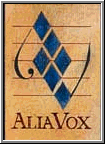|
Sieur de Sainte-Colombe (c.
1640-c.1700)
Concerts à deux
violes esgales |
|
/aliavox_heritage.jpg) |
|
Réédition / Reissued
Alia Vox AVSA9885
Code-barres/Barcode :
7619986398853 |
|
Édition remasterisée |
Remastered edition |
|
Super Audio CD |
|
|
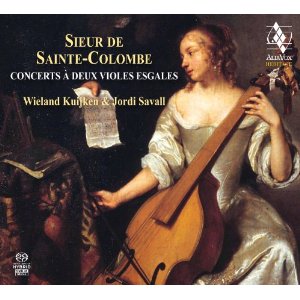
|
Description
Artistes / Performers :
- Jordi Savall (basse de
viole à sept cordes, Barak Norman, Londres, 1697
- Wieland Kuijken, (basse de viole à sept cordes,
Nicolas Bertrand, Paris, 1704)
|
- Tome I
Lieu d'enregistrement / Recording site:
Église romane de Saint-Lambert des Bois, Yvelines
Enregistrement: 01/1976
Recording date: Jan. 1976
Durée totale/Total time: 53'15
|
- Tome II
Lieu d'enregistrement / Recording site:
Église romane de Saint-Lambert des Bois, Yvelines
Enregistrement: 04/1992
Recording date: April
1992
Durée totale/Total time: 61'20 |
|
Tome
I

Édition
originale/Original recording
Astrée - 7729 |
Tome
II

Édition
originale/Original recording
Astrée - 8743 |
|

Naïve 9968 |

Naïve 9933 |
|
|
|
Gramophone-
(11/1993)
Re: Vol I &
II |
 |
|
Subscription
Abonnement |
Reviewer:
Julie Anne Sadie
Full text-:
When the complete works of the mysterious Sieur de Sainte-Colombe
were published in 1973, few viol players had even heard of him.
The music, concerts for two equal bass viols with its
cascades of unmetred notes, was unlike anything seen before. While
of considerable pedagogic interest for the way they teach
musicians to play in an improvisatory fashion, they were
considered rather difficult to bring off in concert. But if anyone
could, it would be Jordi Savall and Wieland Kuijken. In 1976 they
recorded five, which were subsequently reissued on CD in 1988, and
now five more in 1992, in the wake of the success accorded the
fictional film Tous les matins du monde (about the
relationship between Sainte-Colombe and his pupil, the court viol
player Marin Marais), for which Jordi Savall provided the
soundtrack.
There is in fact a tremendous
difference of character between the performances. The earlier
recording now seems to have an air of gruff perfunctoriness about
its pacing, as if the players were somehow ill at ease. The force
of the music had evidently made a lasting impact on Savall, who
used several of the movements—from "Le retour" and the
"Tombeau les regrets"—in the film which he re-recorded
with his former pupil Christophe Coin. It is all the more
interesting that Savall should have collaborated again with
Kuijken on a second CD, and to such extraordinary effect.
We have in the second recording
a series of refined virtuoso dialogues. The rapport between
players and with the music is sublime: elegiac in the extended
passages of echoes in La conference, wonderfully seductive
in Le tendre (which was also used in the film soundtrack)
and almost able to make time stand still in La rougeville.
Gone is the tension one senses in the earlier recording, replaced
by an unrivalled rapport that will be truly satisfying to those
who have avidly followed their musical development during the
intervening years. I enjoyed this second CD immensely.
|
Gramophone-
(02/1978)
Re: Vol I |
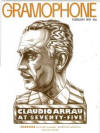 |
|
Subscription
Abonnement |
Reviewer:
R.F.
Full text-:
A rather bizarre review...
! Published for the first edition of vol. I of the "Concerts à deux
violes esgales" by Telefunken - LP 6.42123 AW in the "Das Alte Werk"
collection.
It is an occupational
hazard for record reviewers that they are sometimes sent music by
composers they’ve never heard of. Naturally I hoped to be able to
pass on a few sentences from the sleeve-note writer, but it turns
out that he knows scarcely any more than the nothing that I know.
Even the composer’s;s christian name is forgotten. But it does seem
likely that Sainte Colombe taught that other composer for the viola
da gamba, Marin Marais, and it is quite certain that he composed (in
the late 1600s) as many as 67 of these viola da gamba duets. But are
they for viola da gamba? "Deux violes esgales" suggests they were
meant for any size of viol, and on this record the sound does get
improbably growly when both instruments are playing at the bottom of
the compass. The sleeve is not too reliable about distinctions in
this field, attributing "15 viola da gamba fantasies" to Purcell,
and elsewhere translating viola da gamba as viola. Another bad mark:
there is nowhere a list of the items in each “concert”.
I was unsurprised to be
told that the significance of the titles is for the most part
"incapable of interpretation". Much the biggest “concert” is La
dubois. It starts with a long rhapsodical piece which must be
difficult technically and even more difficult interpretatively, and
it is much to the credit of the players that they make sense of it.
It must be fascinating to work up a deux the sort of rapport that
results in such unanimity, and of course this music was primarily
intended for the players. But as a mere listener I must confess that
the record does rather seem to go on and on, and if they are
thinking of bringing out the Complete Works I shan’t be queuing up
for them. The little dances are sometimes mildly charming, but often
not charming enough. I enjoyed some movements, such as the sad
little piece at the beginning of Tombeau les regrets, but this is
really a record for other gamba players and specialists in the
period. The playing is outstandingly sensitive and musicianly.
|
|
| Diapason # 600
(03/2012) |
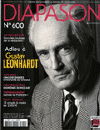 |
 |
Abonnement
Subscription |
|
Chroniqueur: Gaëtan Naulleau
L’éditeur Michel Bernstein nous avait confié qu’en janvier 1976, il
n’en menait pas large au volant de sa deux chevaux sur les routes
des Yvelines. Un virage mal négocié, une plaque de verglas fatale,
et la renaissance de la viole de gambe devait repartir à zéro — il
conduisait les deux champions de l’instrument oublié à la petite
église romane de Saint Lambert-des-bois. On connaît la suite, Jordi
SavalI et Wieland Kuijken exaltant d’un seul souffle la majestueuse
mélancolie de Sainte-Colombe, les micros idéalement posés par Thomas
Gallia, la magie des résonances qui devenait pour tous les
aficionados l’emblème de l’instrument, les spirales sans fin de la
Chaconne rapportée, l’amertume des Regrets... Les
ventes confidentielles se voyaient décuplées, seize ans plus tard,
quand Tous les matins du monde triomphait sur les écrans
tandis que Savail et Kuijken reprenaient la route de
Saint-Lambert-des-bois. Un élégant digipack réunit leurs deux
disques Sainte- Colombe. Magie, toujours. |
Classica # 33
(06/2003)
|
 |
Appréciation

Evaluation |
Abonnement
Subscription |
Chroniqueur:
Article co-signé par J.-N. Coucoureux, S. Friedrich, S.Perreau
Résumé ou abrégé: en
référence au tome I
Les chroniqueurs de Classica
proclament cet enregistrement: "disque de
référence". Ne nous y trompons pas toutefois; cette
musique a été enregistrée bien avant que Savall ne nous fasse
découvrir par le film d'Alain Corneau ("Tous les matins du
monde") l'univers musical de Sainte Colombe. Il faut avant
tout voir dans ces concerts à deux violes "esgales"
"... une illustration de l'art de la conversation élégante,
de la joute technique davantage qu'une quelconque évocation
des sombres pensées d'un ermite retiré dans sa cabane de bois
!" Effectivement, "ces pièces sont plus lumineuses
qu'il n'y parait."
"Savall et Kuijken, les deux géants de la viole, conversent
le plus agréablement du monde, comme on l'aurait fait dans un
intime salon parisien".
|
Classica # 20
(03/2000) |
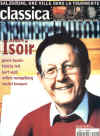 |
Appréciation

Evaluation |
Abonnement
Subscription |
Chroniqueur:
Stéphan Perreau
Texte intégral: en
référence au tome II
"Comme deux restaurateurs consciencieux, Savall et Kuijken
suivent les pas du secret Sainte Colombe, compositeur obscur et
solitaire remis au goût du jour par le film Tous les matins du
monde. Lui aussi remasterisé, l'enregistrement nous emmène
dans les sphères les plus hautes de l'émotion humaine. Un des
plus beaux disques de viole à notre connaissance."
|
|

12:1 (Sept/Oct 1988)
|
 |
Abonnement
Subscription |
Reviewer:
Edward Strickland
COUPERIN
Pièces de Violes 1728: First and Second
Suites. • Jordi Savali and Ariane
Maurette, viole da gamba; Ton Koopman, harpsichord.
• ASTRÉE E 7744
SAINTE COLOMBE
Concerts for Two Equal Viols. •
Wieland Kuijken and Jordi Savali, viole da
gamba. •
ASTRÉE E 7729
These recordings
date from 1976 and have been available for some years in LP format
from Astrée, and in the case of the Couperin from Telefunken as well.
The CD transfers boost the volume quite a bit, especially in the
Sainte Colombe, which may be a shade too aggressive sonically.
Nonetheless, both CDs have real immediacy and provide a great deal
of pleasure.
The
Couperin is still recommended to all and sundry. The viol pieces do
not receive that much attention relative to other works of his, and
this is a shame, for they are often rapturously, if lugubriously,
beautiful.
Sainte Colombe is equally lugubrious, and indeed the highlight of
the five suites presented here remains Concert XLIV: Tombeau Les
Regrets. Indexing is by suite, which is an annoyance, since the
suites range from seven to 18 minutes in length. Thus LP access is
easier than CD. In addition, the LP notes reappear here in slightly
abridged form. Sainte Colombe, as is well known, ended Marais'
studies with him, saying he had nothing more to teach him, and in
fact the student far surpasses the teacher as a composer.
Nonetheless, this disc has great charm and feeling, thanks to the
placement of the deux violes esc/ales in the equally gifted
hands of Kuijken and Savall.
This article is
available on the web to
subscribers of Fanfare. |
|
| |
Autres références disponibles via la base de
données de Todd McComb/ Other available references via
Todd McComb's database:
(Site: http://www.medieval.org)
Re:
Vol. I -
Astrée - 7729
-
Re:
Vol. II -
Astrée - 8743
 Article fort intéressant à propos de
la viole de gambe:
Article fort intéressant à propos de
la viole de gambe:
"La
vie après la mort ~ La viole de gambe au XVIIIème siècle"
par
Peter Holman
Paru dans: Goldberg, # 42 (Octobre 2006, pp. 48-58) |
|
|
|
|
To order / Commander
Réédition / Reissued
Alia Vox AVSA9885
Code-barres/Barcode :
7619986398853
 |
|
La viole de
gambe
Parutions
récentes |
Viola da gamba
Recent
releases |







